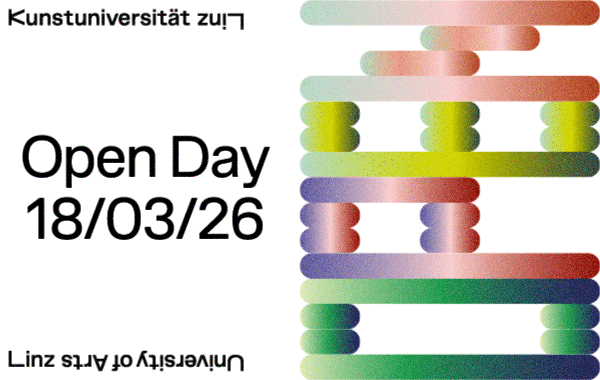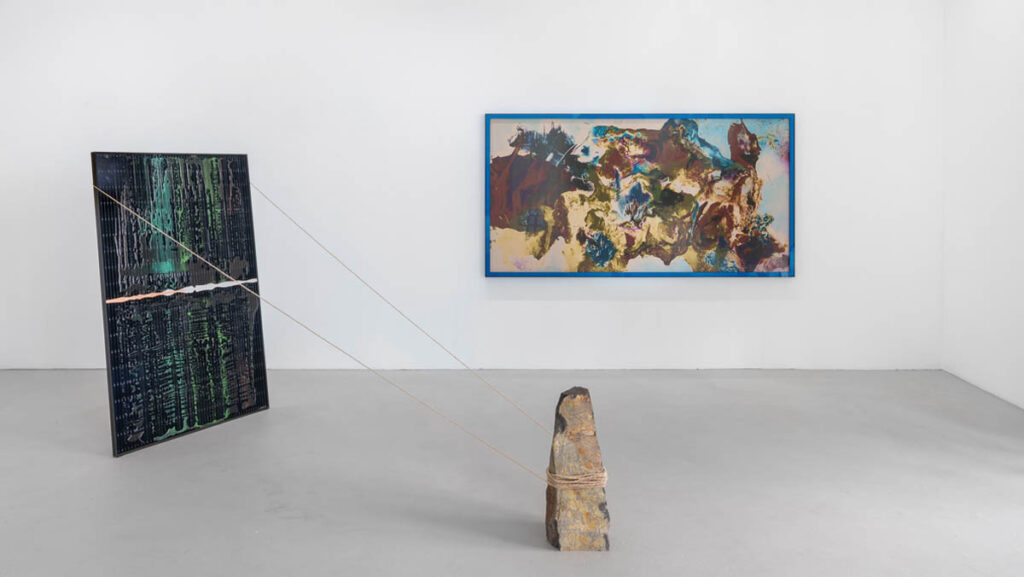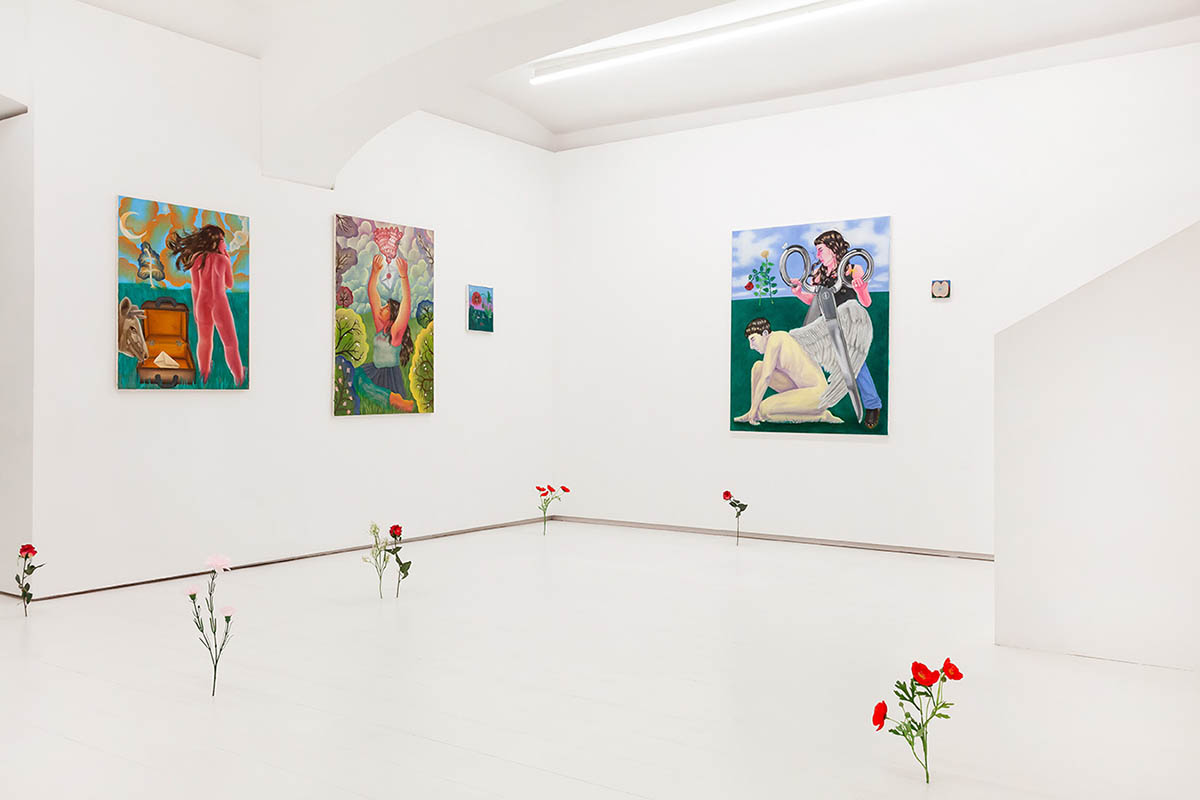
Developed while under the tutelage of Daniel Richter at the Akademie der Bildenden Künste Wien, these canvases position Ramsko’s own image at the centre of a mutable archive of symbols, inviting viewers to negotiate the space between playful artifice and subtle disquiet.
You place yourself at the centre of your paintings. How did that approach lead you to develop Symbolfelder?
Beyond my formal training as a painter at the Akademie der Bildenden Künste Wien, I position myself as an artist-figure, quite literally, the subject of my own work. Yet, it’s never about self-aggrandisement, vanity, or egotism. By ‘rubbing up against’ my own likeness, I deliberately fracture fixed ideas of identity, opening a space where the body can queer itself, dissolve, and discover new modes of being. That very tactic gave rise to Symbolfelder, a painting series involving pictorial dreamscapes populated by personal emblems and collective icons. Scarlet poppies bleed into half-sliced apples, and teary-eyed mourning cows lock their gaze on your own; enigmatic keys dangle beside love letters tumbling from avian wings; and pearl necklaces coil like fragile memories. Each motif functions like a visual cipher, simultaneously intimately personal and broadly communal. Think of it as a form of storytelling, inviting viewers to construct their own narratives across these shifting fields.

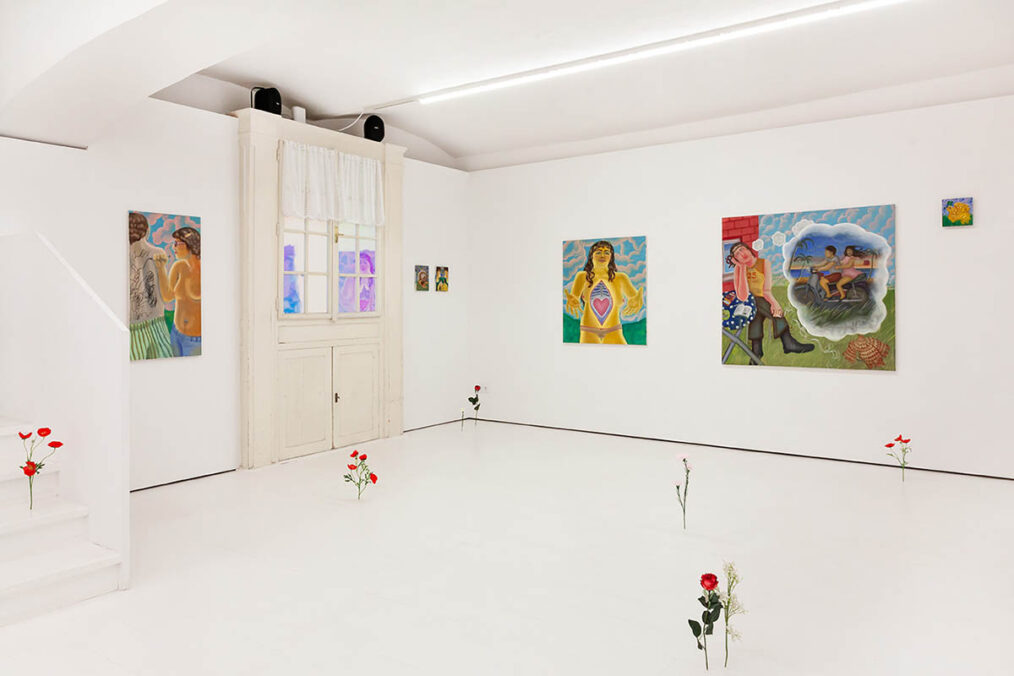
With Symbolfelder’s lexicon established, you use pastel hues and faux-luxury motifs to disarm the viewer. How does that strategy inform your understanding of kitsch?
Kitsch, for me, isn’t a guilty pleasure; it’s a way of knowing that refuses cultural gatekeeping. It’s liberating, to be honest. What others dismiss as tacky or garish becomes my toolkit: pastel gradients that bleed into one another, frothy clouds that hover like daydreams, and gilded ornaments that wink at faux luxury. I lure the viewer in with these sweet or shiny surfaces, only to upend expectations when darker, more unsettling Gothic symbols slip beneath the surface. This playfulness is no accident; it’s a tactical rupture of the “good taste” myth. By amplifying the gap between surface and trace, between candy-floss shimmer and ink-black-mark, I open a space for uneasy confrontation. The moment you recognise that your childhood comfort zone has teeth, you’re forced to reassess your own attachments and aversions. Kitsch, in my hands, is a visual language of contradictions: joy and menace, nostalgia and critique, innocence and insinuation. It’s queer in its capacity to dissolve binaries, high/low, sacred/profane, and to reveal the porous boundary between sincerity and irony. Yet, beyond any intellectual gambit, kitsch is simply a part of who I am: a lifelong flirtation with the absurd and the uncanny.

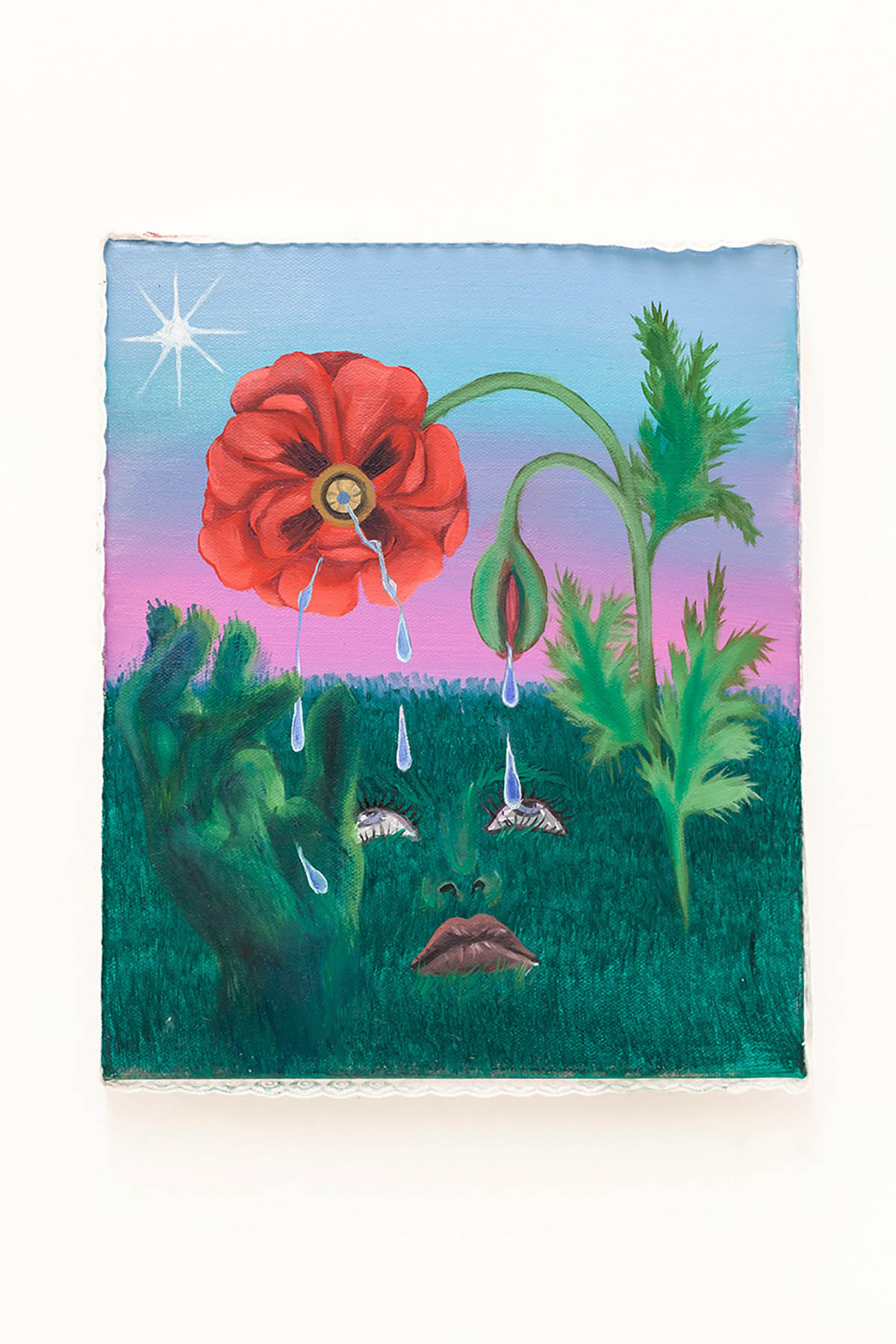
Many of your fields carry a haunting sense of vulnerability. Do you see vulnerability itself as a symbol in your work? How does the dynamic of attaching and undoing inform the emotional landscape of these fields?
In my practice, symbols function less like emojis and more like an uncanny grammar drawn from Surrealism, folklore, and the debris of daily life; mythic fragments and dream scenes that help me wrestle with personal and collective trauma. Exposing those fragile edges can be painful, but vulnerability itself becomes a potent symbol: a knot in the psyche that refuses tidy closure. On the Symbolfelder canvases, that vulnerability is literally built into the skin of the work. I’ll “attach” a pearl-necklace motif in glimmering impasto, only to “undo” it with a memory scar. Each act of embellishment is immediately shadowed by an erasure or incision so that the field feels alive with the tension of becoming (and unbecoming). This push-pull of accumulation and removal mirrors how we attach to, and detach from, our own stories. The result is an emotional topography that functions between invitation and warning, comfort, and collapse. In a world so quick to harden into certainty, I want these fissures to remind us that genuine connection thrives in the space opened by our shared fractures, which requires a willingness to be unsettled.
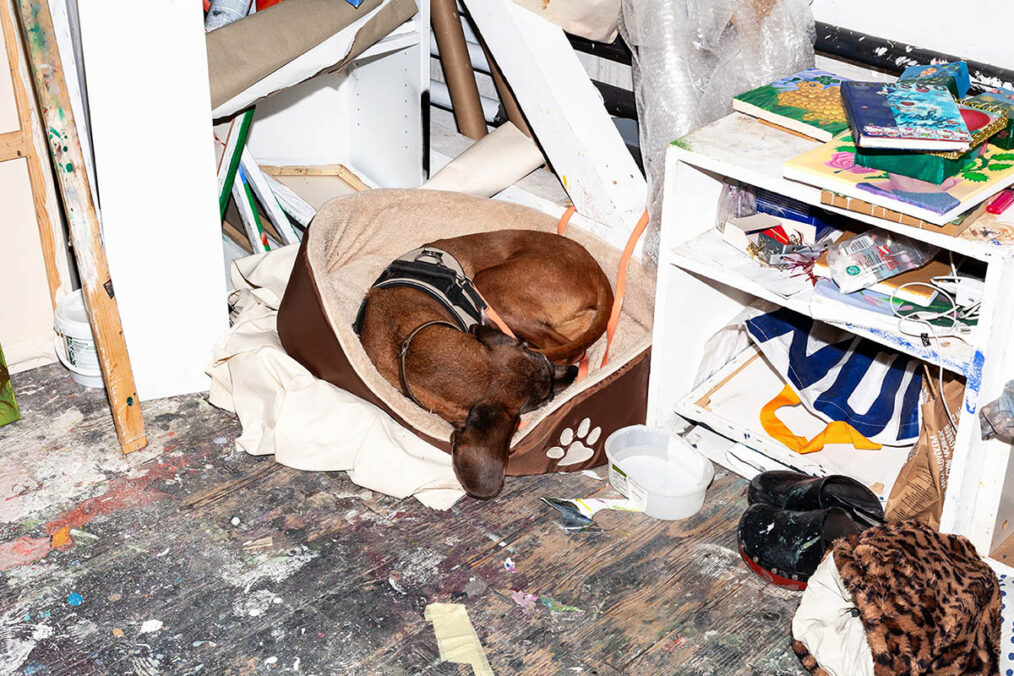
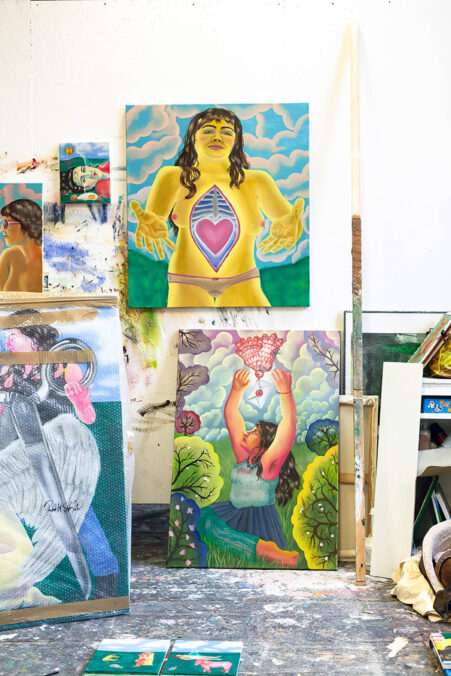
I’ve noticed your rhinestone-studded sketchbooks in your studio. Let’s discuss a flash-in-the-pan gesture: a doodle, a splice in your ground, a stray mark, what made you decide it deserved to become a recurring emblem?
In my studio, those rhinestone-encrusted sketchbooks sit like a personal Tarot deck; each page a card I draw when I need a spark. I’ll shuffle through them until a raw, half-erased doodle leaps out, and treat that mark as an oracle rather than a premeditated plan. That split-second of discovery demands immediacy: I transfer the gesture to canvas, trusting the first-flash intuition. One Tarot reading might spotlight a symbol that recedes in the next. This fluidity means symbols aren’t confined to one image, but thread through the entire system. I paint quickly. It ensures each field remains alive in its imperfection, its instability. That is the choice if ever there was one.
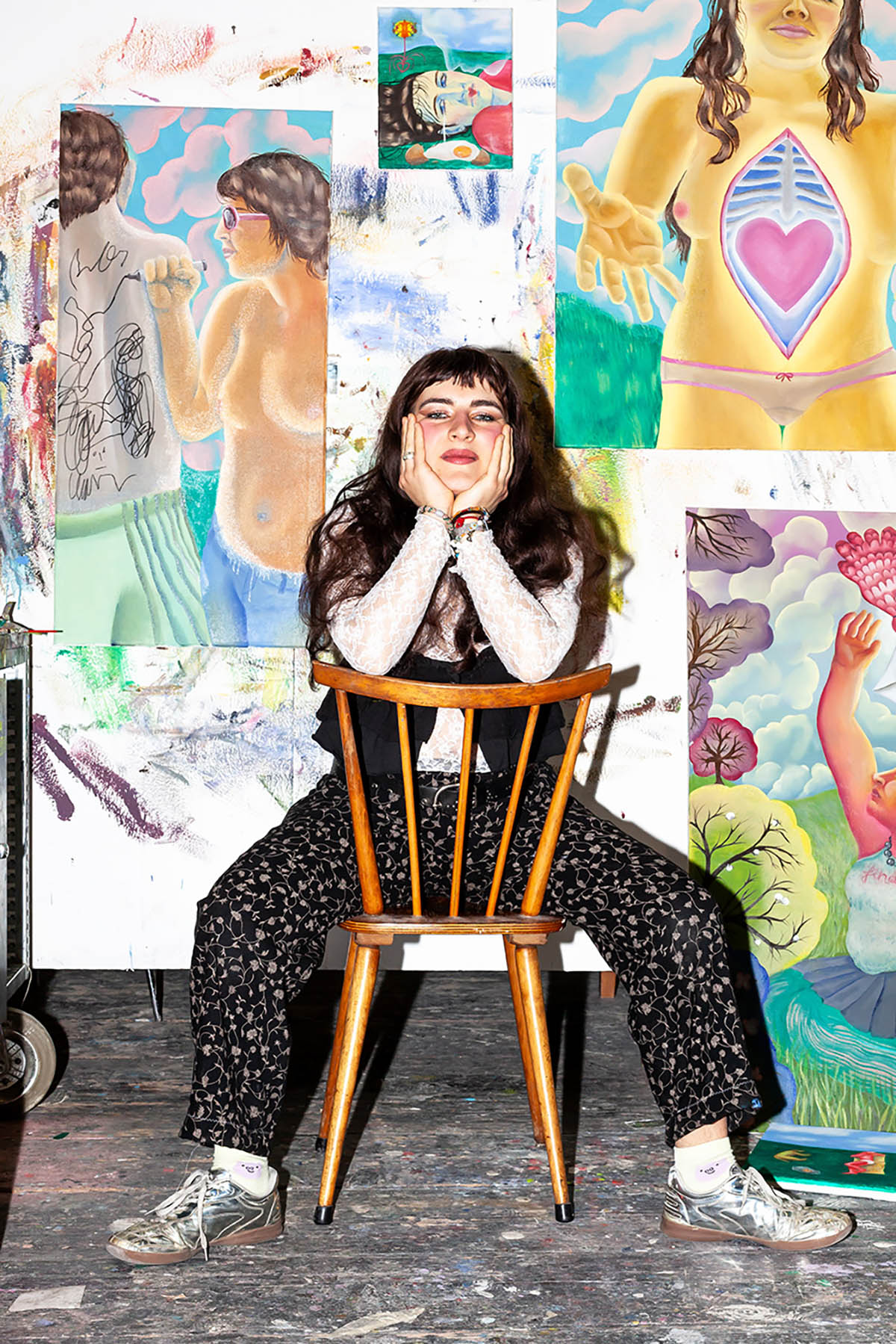
As the doors of HALLE13 click shut behind them, what residual tremors of Symbolfelder do you hope viewers carry into the world?
I want them to step out enchanted and slightly off-kilter, aware that nothing in the world—not even their gaze—is set in stone. If a motif they breezed past in the gallery suddenly blooms in their mind, or if a hidden configuration reveals itself when they revisit the series online, then the work has done its job. I imagine the exhibition as a living garden: shifting moods of vulnerability, playful confrontation, and radical empathy that swirl long after you’ve left the room. Above all, I hope people leave with a simple, stubborn pleasure in the strange details so that these subtle surprises stay with them long after. And let’s not overlook the in-gallery playlist, my sonic concoction looping through HALLE13: shamelessly kitsch meets unashamed delight. Prepare to love it while you mock it.
Spotify-Playlist Symbolfelder: Link
Exhibition: Ramsko – Symbolfelder
Exhibition duration: 08.05. – 14.06.2025
Opening Hours: Thursday & Friday 2-6 PM | Saturday 12-4 PM Or by appointment (Please note that the gallery will be closed on June 5th, 6th, and 7th.)
Address and contact:
HALLE13
Elisabethstraße 13, 1010 Vienna
hallo@halle13.net
www.halle13.net
Ramsko – ramsko.art, www.instagram.com/ram5ko/



